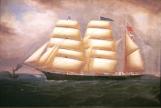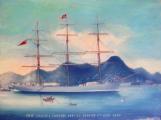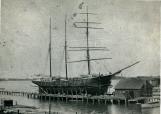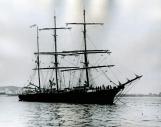1
Yarmouth ships, like all other merchant vessels, were built as a business investment. They were built to make money and they did this by carrying goods from one port to another. The 'Golden Age of Sail' comment on the second half of the 1800's is a modern term; and an inaccurate one. Lots of money was made by some owners but for most people involved with ships it was hard work, long periods away from home and family, little pay, hard business decisions and, in too many cases, it was disastrous. There were, of course, success stories. Some people, mainly the owners and captains, were financially successful.Many Yarmouth vessels were built in the area but they never actually visited their home port. Instead the 'tramped' the world trying to cover their expenses and to provide dividends to their owners. And travel they did!
3
A good example is the barque 'Neophyte' which, during its Yarmouth ownership (1892-1896) crossed the Atlantic Ocean some 65 times and visited a total of 30 ports: Liverpool, England (11times), Quebec (8 times), Saint John, NB, Mobile (both 5 times), Cardiff (4 times), Greenock (3 times), Pensacola , Port of Spain, Montevideo, Rio de Janeiro, Darien, Chatham, NB, Philadelphia, Cape Town, Cork, Bangor, Sharpness, Dublin (each 2 times), and Queensborough, Londonderry, Barbados, Newport News, Tadoussac, Yarmouth, Rosario, Hull, Middlesborough, Barrow, Bremen, and Troon (once each). That's travelling for you!5
Story 2 (A Brief History of Yarmouth Shipping) mentioned to illustrate the importance of Yarmouth vessels in world trade we can cite the following: in 1876 Yarmouth vessels made over 800 calls to at least 156 ports around the world. Much of this trade was Transatlantic with Liverpool, England being the most visited port (77 visits). However, they also called at ports in Africa, India, the Far East, Australia, and both East and West Coasts of both South and North America. Later on, in the 1880's and 1890's, our ships travelled to these faraway places more often.7
Yarmouth vessels (and others captained by Yarmouth men) carried bulk cargoes such as:-coal, from South Wales to coaling ports such as Rio de Janeiro, Buenos Ayres and Cape Town
-coal from Newcastle, Australia to South America
-oil from Philadelphia, Baltimore and New York to the Far East, including Japan, Shanghai, Hong Kong and the Philippines
-sugar from the Philippines to Europe and from the Caribbean to the United States and Europe.
-jute from India to Europe and the United States
-grain from Portland, Oregon and San Francisco to Europe
-guano from Chile and Ecuador to Europe
-wood from Canada and the United States to Europe and South America
-general cargo from anywhere to anywhere






